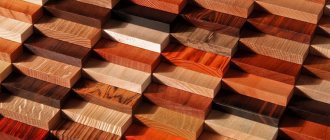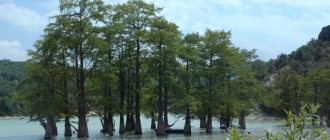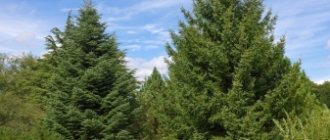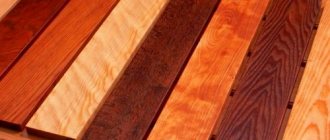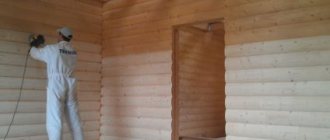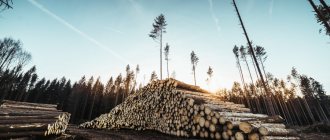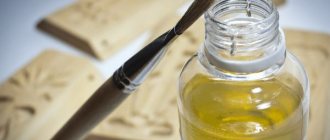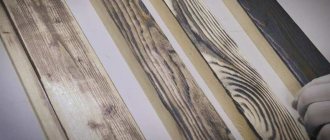For centuries, wood has been considered, although valuable, but a fragile material that is susceptible to rotting, attack by parasites, drying out and other troubles. It was only at the end of the last century that a process was developed in Finland to avoid damage to wooden products during use. Heat treatment of wood has become a salvation for lovers of structures and finishing made from this raw material. Now even the most inexpensive type of wood can look presentable and have a rich and noble shade.
Process description
| This section need additional quotes for verification . |
The three processes are carried out in one step using oil (oil heat treatment), nitrogen (Reti wood) and steam (Le-Bois Perdure).[1] The wood heat treatment process consists of drying, heat treating and finally cooling/conditioning and takes up to 72 hours. The Plato process consists of hydrothermolysis, dry curing and conditioning and can take up to 7 days. The time required depends on the wood species, width and initial moisture content.[3]
Westwood process
Westwood is the world's most advanced thermal modification process, patented in 2004. The process was originally developed for treating hardwoods, which are more complex than softwoods due to the thermochemical reactions that occur in hardwoods during heat treatment. Westwood's fully automated control system allows you to control the heat treatment of any hard or soft wood.[4]
Platonic process
A two-step process in which water-soaked wood is first hydrothermally treated at 160–190°C and high pressure. Once the moisture content of the wood is reduced to 10%, a curing stage is carried out at 170–190 °C under 1 atm pressure.
Re-certification
Retification refers to the French word rewriting
, which is a portmanteau
of reticulation
(creating chemical bonds between polymer chains) and
torrefaction
(baking). In this process, the wood must have a moisture content of 12% or lower, which can be achieved through simple drying processes. The wood is then placed in a high nitrogen atmosphere with no more than 2% oxygen.[5]
Les Bois Perdure
Freshly sawn timber must first be dried and then heated in a steam environment, using the remaining moisture in the wood.
Heat treatment of oil
The wood is placed in an oil bath at temperatures ranging from 180°C to 220°C. This process can also be used with chemical additives to modify the wood in other ways.
Thermowood
This process is similar to Les Bois Perdure in that it uses steam at atmospheric pressure to treat the wood. However, this process can also be used for green wood and has been the most widely used commercial process since 2004.[3]
Step-by-step manufacturing instructions
There are two manufacturing options. The first is suitable for those who do not have a suitable kiln and do not need to burn large volumes of wood. The second is for those who still have a stove that is more or less suitable for such purposes.
Cooking in water
Place the preparations in a large pan, bucket or barrel. Pour in the required amount of water. Place on fire (it is important to maintain maximum temperature). If the water evaporates, add boiling water. Boil for 2 hours. Take out the blanks. Wrap in newspapers (several layers). Place near a heat source.
In a few days you will receive wonderful material that will fully meet the requirements you need.
Firing in a kiln
First you need to make sure the wood is dry.
It is important that it has not been treated with chemicals, paints or varnish
- Preheat oven to 200 degrees.
- Place the workpieces on a wire rack, which is best placed in the lower part of the oven (you can first lay down paper).
- Place a container of water at the top.
- Dry the wood in the oven for 2 hours.
- After 2 hours, add water to the container.
- Reduce temperature to 100 degrees.
- Wait another half hour.
Such wood will last you a very long time. It tolerates any temperature well and does not require the use of reagents.
Characteristics of thermally modified wood
The main advantage is that softwood can be used for applications that require high strength, which can be considered environmentally friendly. Strength classes 1–3 according to the European standard EN 350-2 can be obtained from weak (class 5) softwoods.[6]
The main disadvantage is the decrease in strength due to high temperatures. Typically, flexural strength decreases by up to 30%, with a greater decrease at higher temperatures.[7]
Biological resistance against some (not all) microorganisms and insects increases. However, due to the decomposition of volatile organic compounds (VOCs), the antimicrobial properties of wood can also be reduced. [8]. Shrinkage and swelling are reduced by up to 50–90%.[9] Treated wood darkens slightly in color.
As a rule, the heat treatment process can be carried out on all types of wood.
Heat treatment of wood at home
To create thermowood with your own hands you will need:
- A tank that can be closed so tightly that air will not flow in.
- Ensure constant uniform heating of the entire area of the tank.
- A container with liquid to create thermal steam inside the tank.
- Tool for placing raw materials.
Operating principle: a piece of wood is placed inside the tank, the structure is continuously heated, most often electrically, to a temperature of at least 135 degrees.
Another simple option for heat treatment of small pieces of wood at home: boil it in a saucepan for 1.5 hours, wrap it in a towel and let it dry next to the heater. This method is relevant for those who do wood cutting.
Thermowood is an environmentally friendly material. Does not require special coating, can be used for both exterior and interior decoration. Does not respond to precipitation and temperature changes. It will serve its owners for decades, maintaining its noble appearance and protective qualities.
Technology maturity
Heat-treated wood is not just an academic topic these days. Heat-treated wood has been making its way into the market for several years now. There is also some industrial contribution to research and development. The Natural Resources Research Institute at the University of Minnesota Duluth maintains a pilot kiln to study the effectiveness of thermal modification of underutilized Minnesota tree species to expand timber markets.[10]
In the guitar industry, this process is called, among other things, "heat cure", "baked" and "fried". [11] Some guitar manufacturers have begun using acoustic soundboards and electric guitar necks that are thermally cured to prevent the typical warping and cracking that often occurs due to seasonal humidity fluctuations. An added benefit is that acoustic guitars tend to sound like well-aged instruments much earlier than non-heat-treated guitars.
Flaws
Among the disadvantages, one can note the fact that heat-treated boards are quite expensive.
However, taking into account the unlimited service life and many unconditional advantages, the disadvantage becomes less significant and determines the purchase.
Despite its resistance to UV radiation, experts still recommend treating the material with protective impregnations.
Although the sun's rays are not capable of harming the physical and mechanical properties of products, they can harm the decorative layer. A surface not treated with a protective coating will fade after a few years.
Major companies in the industry
In the United States, the largest heat treatment manufacturer is Westwood, which was the first to launch heat treatment production in the United States in 2007.[12] In Europe, the production of thermally modified wood on an industrial scale is concentrated mainly in Estonia. Estonia is geographically close to the main Finnish producers of thermal kilns, and labor and overhead costs are lower than in Finland or the Scandinavian countries. At the end of the 1990s, three main Estonian producers of thermally modified wood emerged: Brenstol OU, Tre-Timber OU and Ha-Serv. All 3 companies focus on supplying materials for saunas and interior flooring - Brenstol specializes in hardwood, and Tre-Timber specializes in softwood. In the early 2000s, Brenstol acquired Tre-Timber, becoming the largest producer of thermally modified wood.[13]
Around the same time, the market for thermally modified wood expanded dramatically from its traditional use in sauna materials to include exterior products such as decking.[14] and cladding (siding)[15]. While Ha-Serv continued to focus primarily on the Finnish sauna market, Brenstol founded the Thermory brand and began exporting to Europe, Japan and Thermory became the most recognized brand of thermally modified wood in these regions. [16] The market for heat-treated exterior materials grew rapidly as European consumers increasingly sought alternatives to tropical woods from Asia, Africa and South America. Turkish producer, Nova Wood, has also started producing thermally modified wood and has become a minor player in European markets.
In 2012, Brenstol opened a US subsidiary, Termori USA, and began aggressively expanding into markets around the world. The Thermory brand is well established in the United States and Canada and is sold in more than 55 countries worldwide.[17] In 2016, Thermory had revenues of €29 million and profits of €1.8 million.[18]
Small local producers continue to emerge in each region, but there are high barriers to entry into the thermally modified wood market, especially thermally modified hardwood. Proper thermal modification equipment is extremely expensive. Additionally, because the technology is not well known, there is little publicly available information on drying schedules, and many new producers of thermally modified wood experience high rates of drying defects, discoloration, brittleness, equipment failures (including fires), and inability to achieve the high durability ratings achieved more well-known manufacturers such as Brenstol (Thermory). In 2022, Thermory acquired Ha-Serv, becoming a leader in the heat-treated wood segment. [19]
Recent research into the heat treatment process has shown that coloration of wood during heat treatment is not necessary, resulting in durability and stability: the reactions responsible for color change during modification are different from those responsible for durability. Not all brown wood should be considered truly thermally modified.[20] Currently, Westwood is the only technology that has implemented these changes in the thermal modification process to produce truly durable and stable thermal modified wood in the industry.[ citation needed
]
Where is thermowood used?
Thermally modified wood is not only aesthetically pleasing, but also a reliable material for external and internal finishing of terraces, cottages, wooden houses, summerhouses and even floor coverings.
Thermowood is used everywhere:
- In gazebos, on summer verandas - such areas are unheated and open. That is why, when designing and constructing, you should think about using a stable and durable material that is “not afraid” of temperature changes, winds and heavy rainfall. As a result of using TMD, structural elements will retain their original quality and appearance: floors and walls will not crack or dry out - there will be no need to renew the coatings annually.
- On facades, thermal board cladding will last for many years and retain its original appearance. In addition, such a facade does not require special expensive maintenance - classical means will do.
- In baths, saunas, bathrooms and adjacent areas. Thermowood has excellent resistance to moisture, mold and mildew, heats up slowly and practically does not conduct heat.
- On country and garden paths. Such elements will not only decorate the site, but will also greatly facilitate access even in the most unfavorable weather conditions. The material can withstand increased loads, which ensures its durability.
Current research
Research is ongoing[21] to optimize production processes and various parameters for its production, as well as to develop applications for this wood. Research is also underway to find new heat treatment processes for wood, even attempting to combine different wood modification processes.
Finally, research is ongoing to understand the chemical changes that wood undergoes during heat treatment.
